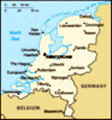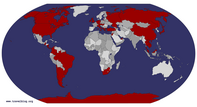Advertisement
Published: July 13th 2018
Up at 7 am, bags out at 7:30. We had said a lot of good-byes at the party last night, but over breakfast and while waiting in the lounge for our call, we chat with our fellow cruisers and exchange contact information. Truly a great bunch of people with whom we have been privileged to share the ship these past two weeks.
We transfer from the ship at 9 am. Both boarding and disembarking are quick and easy on a river boat compared with the mammoth undertaking of loading and unloading passengers on big ocean cruise ships. Here you just walk down the gangway. We share our cab with an older couple whom we have not met before. They are going to a hotel near ours. Only about 30 minutes until we reach our hotel, the Grand Hotel Downtown. We check in and settle in. Comfortable room with a very high ceiling but somewhat cramped. We feel the usage of space could have been better thought out.
We had earlier decided that we would purchase an "iAmsterdam" pass for the duration of our stay in Amsterdam. This pass gives you complete access to all forms of public transit (tram,

 Amsterdam canal scene
Amsterdam canal scene
Amsterdam, Netherlandsbus, subway) plus free entrance to most of the city's museums. But where to purchase it? The purchase can be made online but they only offer to mail it to you, which obviously won't work. We ask our hotel concierge, who tells us he thinks that they are sold here, putting a little x on the city map. OK, it looks like a fair hike but once we have a pass we can take transit back, right? So we set off, armed with our map.
It's windy and threatening rain, and in fact little bursts of raindrops occasionally assail us as we stride the streets of Amsterdam. The city architecture is typical of many European cities, but the magic is that you can barely walk a block without crossing a picturesque little bridge over a picturesque little canal. There are several cities in the world that call themselves the "Venice of the (insert geographic reference)", but we have seen Venice ourselves and there's no doubt that Amsterdam's claim to be the "Venice of the North" is well founded.
We're not entirely sure where we're going but eventually we do find a store near the x on the map

 Rijksmueum
Rijksmueum
Amsterdam, Netherlandsthat sells tickets of various kinds. However, disappointment. They do not sell the iAmsterdam pass here. Where can we buy it, then? Two bridges back maybe, the guy says, at some place called the "Blue Boat". So we truddle back the way we came, looking for something that says "blue boat". No luck. Wife's getting seriously annoyed at me. Then I recall that I saw another ticket kiosk a short distance along a canal that we crossed earlier. Eureka! They sell the iAmsterdam pass there. A nice young lady explains the various options and how it works. Mission accomplished.
Now that we have passes, we can use public transportation. The tram seems easiest. We plot a course for the Rijksmuseum, Amsterdam's main art gallery. Using the tram is easy. The stops are usually on an island in the middle of the street. A display at the stop tells you when the various numbered trams will arrive, typically within a few minutes. As you enter the tram, you tap your pass on the reader (one beep) and tap again as you exit (two beeps). As we learn later, inspectors randomly board to check for valid passes. Violet is using a
cane, and sitting passengers are very good about getting up to offer her a seat. And if a young man lost in his earbuds fails to yield a seat, an older lady sitting nearby will give him a poke.
We arrive at the Museum Quarter, an area that groups together a number of museums. The Rijksmuseum a huge, majestic 19th-century building. At ground level, a street runs directly through a tunnel in the building. We are required to check our backpack. Our passes get us in without difficulty. The museum has 4 floors, 5000 paintings, and many different collections on display, but we are most interested in its main claim to fame: the Rembrandt and Dutch Masters collection. In the main foyer, we chance upon a paint-splattered Rembrandt himself! Actually, it's an actor, thoroughly embracing his role.
The Rembrandt collection highlights the Dutch school of painting in the 17th century, epitomized by the master himself. The paintings range from portrait-sized to wall-sized. Typical is Rembrandt's famous Night Watch, which takes up a wall of one of the galleries. The colours are luminous and the paintings look three-dimensional, thanks in part to the excellent lighting in the gallery. (Poor
lighting is one of my peeves about some very famous art galleries elsewhere in the world.) A nice touch is that there are large laminated cards stacked near the most important paintings that reproduce the painting, highlight certain salient features, and describe its history and significance. You help yourself to one of these cards and then replace it when you are done. This avoids the crush of people trying to read the information on the wall.
Besides Night Watch and the other works by Rembrandt and Vermeer, standout pieces for us include the Threatened Swan by Jan Asselijn, an amazing and innovative painting of a swan protecting her nest, apparently full of political allegory; a gorgeous piano made for Louis Napoleon; a stunningly lifelike marble statue of Sleeping Beauty by Frans Stracké; and an adorable painting by Jan Havicksz entitled Children Teaching a Cat to Dance, which tells you all you need to know. This museum also has a handful of Van Goghs, including one of his famous self-portraits, but the real show in that regard is yet to come at the nearby Van Gogh Museum.
When we exit the museum and walk through to the other side,
we spy a giant set of red and white letters spelling out "iAmsterdam", a promo for the pass. Apparently, these letters move around the city on a regular basis and you never know where they will turn up. A good photo op.
It is now mid-afternoon and we are quite hungry. We pick a cosy corner restaurant more or less at random. It turns out to be a good choice. We both enjoy seafood kabobs, fries and salad, plus a restorative beer. The fish is terrific, a harbinger of things to come. It's kind of cool to be hanging out in a small Amsterdam cafe, chatting and people-watching.
We tram back to the hotel to freshen up. The weather has gotten better and the sun is peeking through the clouds. Our next appointment is the Anne Frank House. We had pre-ordered tickets for a specific day and time back in Canada before we left. This was smart, because we know that people on the boat had recently tried to pre-order and found it completely sold out.
We descend from the tram at a large stone church with a tall steeple. We've given ourselves extra time because we

 Violet with Anne Frank
Violet with Anne Frank
Amsterdam, Netherlandsdon't want to miss our appointment, and that also turns out to be a smart move because I misinterpret the map and lead us down a street that parallels the correct one. No sign of the Anne Frank House. Eventually with the help of passersby, we locate it. Definitely could have used better signage.
Most people know the main lines of the Anne Frank story--an incredible, heroic and heart-breaking true tale that throws into relief the best and the worst of humanity. In many ways, it is a parable for our times. Briefly, the Frank family, consisting of father Otto, mother Edith, and sisters Margot and Anne, flee Frankfurt for Amsterdam to escape Nazi persecution. After the Nazis take over Holland and when they start to round up and deport the jews there, the family goes into hiding in a secret annex in Otto's workshop. They are joined by four others. Their refuge is aided by two of Otto's business partners and their wives. For over two years, the Franks live in hiding, never leaving the building, always careful to be as quiet as possible. Anne had already been writing a diary, but to pass the time she throws
herself into the task, and eventually rewrites much of it. As the war is winding to a close, they are betrayed by an unknown person, captured and sent to extermination camps. Anne and her sister die of typhoid and starvation in a camp. Of the eight people who lived in hiding, only Otto survives. Anne's diary was rescued from its hiding place and is returned to Otto. He makes it his life mission to publish and publicize Anne's diary.
The Anne Frank house is the actual building in the story. Following the signs, we make our way through it room to room and floor to floor. The story is laid out to us in chronological order with supporting exhibits and audio commentary. Eventually, we slip behind a pivoting bookcase and enter the secret annex. A mere four rooms where eight people lived for over two years.
Two big takeaways for me. First, this experience made Anne a real person for me. Anne was determined to be a writer, and she used her isolation to hone her craft. For instance, she kept a workbook of "beautiful sentences" that she transcribed from books. While reading pages from her diaries and other writings in German, Dutch, French and English, all rendered in beautiful penmanship, I could feel her spirit and personality. Second, I strongly felt the anguish of Otto Frank, who did everything in his power to save his family, almost succeeded, only to have them all succumb to horrible fates, then rebuilt his life around the powerful message of his daughter's writing.
Time for supper. Just across the street is a restaurant called Pancakes Amsterdam that catches our hungry eyes. Various types of pancakes and waffles are very popular in Holland. The restaurant interestingly has a no-cash policy; you can only pay with plastic or mobile device. We order a couple of intriguing combinations: goat cheese, spinach, garlic oil and pine nuts; and smoked chicken, zucchini and tomato tapenade. The pancakes themselves are crepe-like but somewhat thicker than the French variety. With toppings, it looks like a pizza.
Back in Budapest, I had mentioned that there are no Indo-European cognates to draw upon when looking at Hungarian. Here in Amsterdam, there is a shaker on the table labelled "Kaneel Suiker". I know no Dutch, but from English and French knowledge, it's easy to figure out that it contains cinnamon and sugar.
It's close to 8 pm when we finish our supper. We make our way back to the hotel by tram. It's been a long day and we are very tired, but we take time to make a reservation online for the Van Gogh Museum tomorrow. Even though admission will be free thanks to our iAmsterdam cards, because of the popularity of this museum, you are required to prebook your arrival time.
Advertisement
Tot: 0.175s; Tpl: 0.016s; cc: 7; qc: 57; dbt: 0.1261s; 1; m:domysql w:travelblog (10.17.0.13); sld: 1;
; mem: 1.2mb










